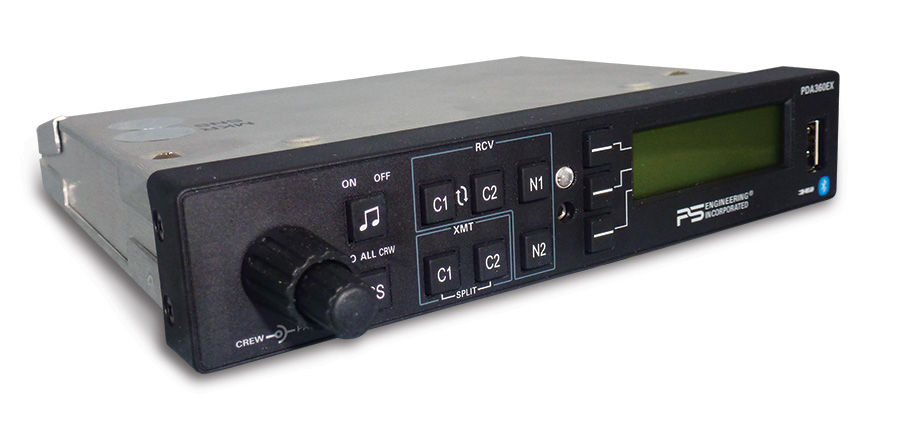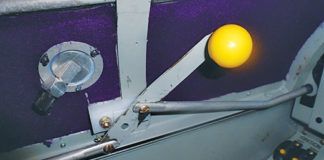Audio panels tend to be an afterthought for many homebuilders. A lot of attention is paid to EFISs, IFR navigators, backup instruments, maybe a backup com radio-and now to ADS-B compliance. But the audio panel is often an afterthought, just something to provide an intercom and switching between the various radios. In fact, there are far fewer “aviation” audio sources for most pilots in the age of GPS-gone are the need for DME, ADF, marker beacons-and for some even the nav receivers (unless you are in the habit of flying ILS approaches). But as aviation receivers in the cockpit dwindle, other audio has begun to dominate: XM music, mp3 recordings, even telephones vie for the pilot’s ear. And that means new technology audio panels need to be considered-and not just as an afterthought.
PS Engineering, long a leader in audio, and a big supporter of the Experimental world, is now offering their latest tech-a fully configurable audio panel with stunning sound, intelligent audio technology to provide directional audio from different sources, and a Bluetooth adapter that makes placing a phone call (on the ground, of course) as easy as pushing a button and talking. And best of all, it is pin-for-pin compatible with several popular Garmin audio panels, so changing to the PSE unit takes nothing more than an Allen wrench and a minute’s work.
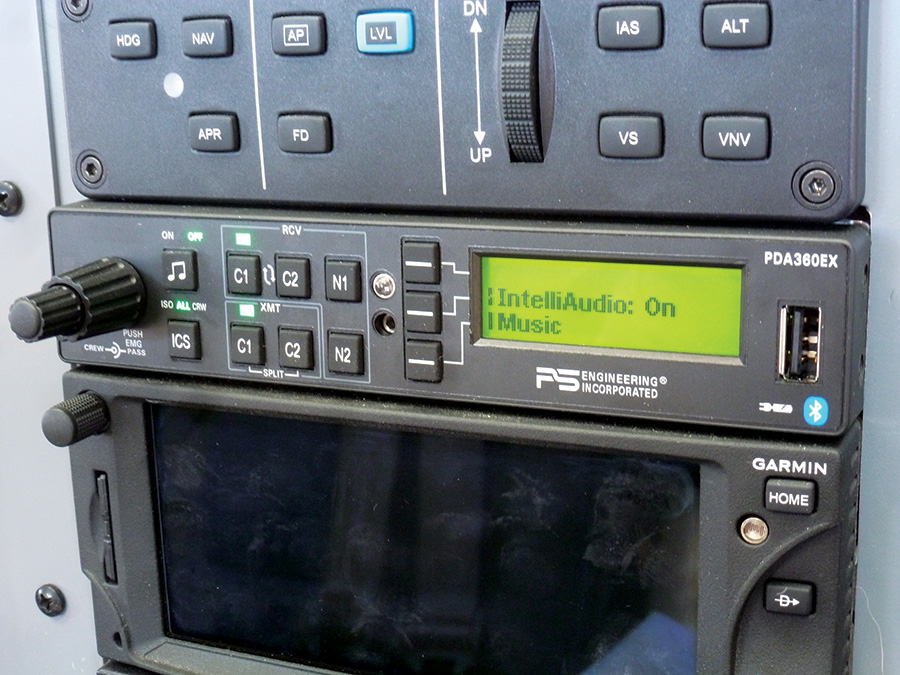
The face of the PDA360EX is designed with fewer buttons than many other panels. The functions of the three softkeys change with the context, and labels appear on the display.
The new PDA360EX is based on the PMA450 audio panel that was introduced to the certified world at Oshkosh in 2014. The PMA450 is the company’s most advanced certified audio panel, and its heritage is very evident in the design of the new 360EX. The 360EX is, however, tailored for the Experimental market, taking into consideration the types of equipment seen in modern homebuilts. For instance, very few Experimental pilots need or want a marker beacon receiver these days, so that is gone. Few Experimental aircraft today incorporate ADFs or DMEs-so while the builder can configure the panel to have buttons for these audio sources, this is no longer a default. Music, on the other hand, is very common, and the 360 provides a dedicated button for enabling or disabling the pilot’s favorite tune source.
Kitplanes tested the new 360 in one of our airplanes for a month, and we found the audio quality to be exceptional for all sources. We don’t know how you make a radio sound better, but the 360 seems to do it. Used with a pair of Quiet Technology Halo headsets, the sound quality was crisp and clear, but not tinny. XM music sounded rich and full. The intercom’s automatic squelch worked well in the somewhat noisy RV cockpit, although when tested in one of our noisier planes, in a redline dive, the intercom broke squelch and air noise accounted for about 50% of the audio heard by the pilot-but this was far better than other audio panels have done under the same circumstances.

The three main functions we tend to use these days are select com 1, select com 2, and turn music on and off. There are dedicated buttons for these three functions.
The unit connected easily to our iPhone via Bluetooth, and we were able to play music as well as place and receive phone calls that were very clear. The technology we were most excited to try-IntelliAudio, which puts the direction of various audio sources in different spots relative to the headset wearer-is very effective.
Overall, the affect of IntelliAudio was stunning; it makes separating multiple voices much simpler. You can actually continue listening to ATC or the CTAF while listening to-and understanding-the AWOS. We have worn headsets and listened to multiple channels for many years, and this is the easiest it has ever been-a huge plus for the design and the product. Most multi-source audio systems simply combine the audio into a single stream, and pulling individual intelligence from each at the same time is a skill that takes considerable time to learn. Getting the voices from different directions shortcuts the learning process, and we predict that pilots will like it well enough that it will become the standard in audio systems in a short time. (Garmin has a similar functionality in their top-of-the-line GMA 350 audio panel, and we look forward to trying that soon.)
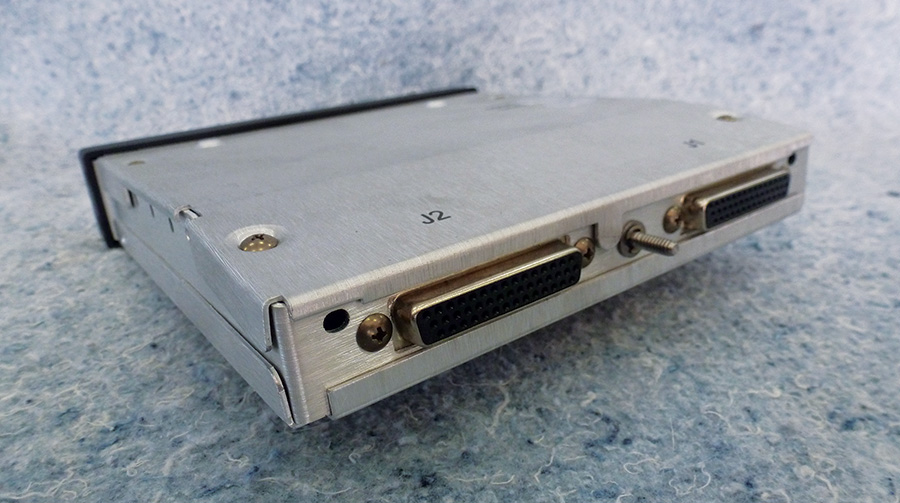
If your airplane already has a Garmin 240 installed, you can slide a PDA360EX into the same tray. All of the connectors are the same.
Hardware-wise, the 360EX looks much like the 450, with just a couple of exceptions. Gone are the marker beacon lights, and in place of the button previously labeled “MKR” is a button with two little musical notes. The label reads “360EX” instead of 450. And that’s it-they are otherwise hard to tell apart. But turn the units on and, functionally, the difference is obvious. The com select buttons work just as before-you can choose to monitor one or both coms, and you can select which one to use to transmit. Music is now controlled from the dedicated button-it is on or off, and this can be selected with a single button push without looking at the panel. When music is enabled, the bottom softkey is used to cycle through the soft mute modes for the music-it can be set to mute when a radio transmission is received, when the intercom breaks squelch, when either event occurs, or when neither happens (this is karaoke mode). The IntelliAudio feature can be turned on or off with the middle softkey (although we’re not sure why you would ever turn it off). If the music is turned off, the bottom softkey is still related to music, but pushing it puts you into the music configuration menu where you can change volumes and sources.
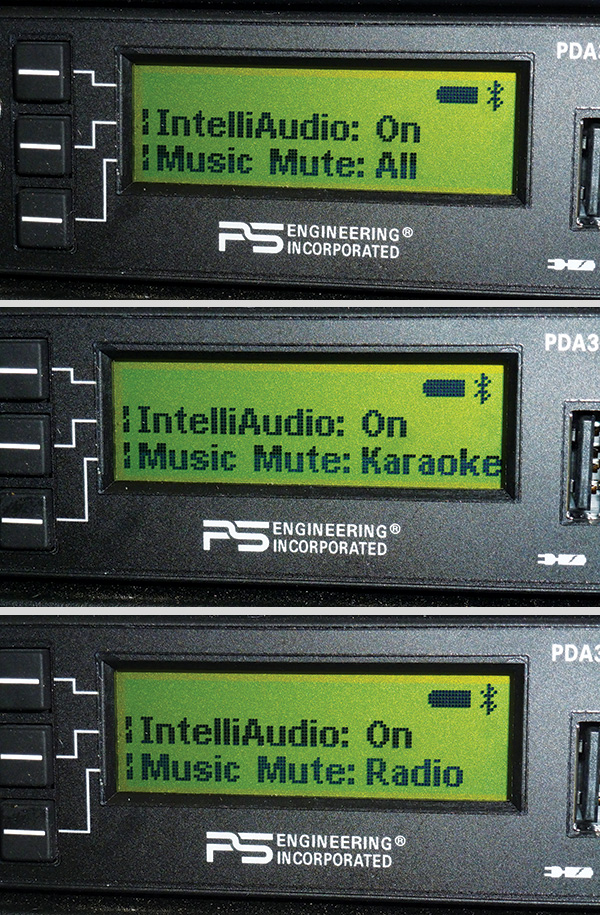
Once music has been turned on with the dedicated button, the lower softkey will cycle between three mute modes as desired by the pilot.
The nav 1 and nav 2 source buttons are still on the panel, even though they are rarely used in today’s GA flying environment-but stay they should because we still need to identify the ILS if we are going to shoot such an approach. DME or ADF? You can use the softkeys to configure for those, if you like.
The Bluetooth interface worked extremely well with our iPhone. Once linked, the display showed the battery level of the phone-a good indication that they were talking. We could play music from the phone or place a call, which was crisp and clear on both ends. The USB port on the front panel of the 360EX is a power outlet that can be used to charge phones, iPads, or what-have-you.
The ability to slide the new unit in and out of a Garmin-wired airplane is great for demos and testing like we were doing, but it also means that changing from one brand of audio panel to the PSE is very simple. All it takes is an Allen wrench and 30 seconds of your time. We traded our demo units between two different airplanes as easily as we changed pilots. The connections use standard D-sub pins and sockets-easier to work with than the company’s early-generation units with Molex connectors. Having wired up both types, we strongly prefer the simplicity and clean design of D-sub and are glad that most avionics manufacturers are going this way as well.
Overall, we found the 360EX to be a robust, high-quality audio panel well suited for the Experimental market. If you are looking for a panel for your new project, or a way to upgrade to a more capable unit with Bluetooth to be able to talk with ATC on the ground through your phone, the 360EX is definitely worth a look.

